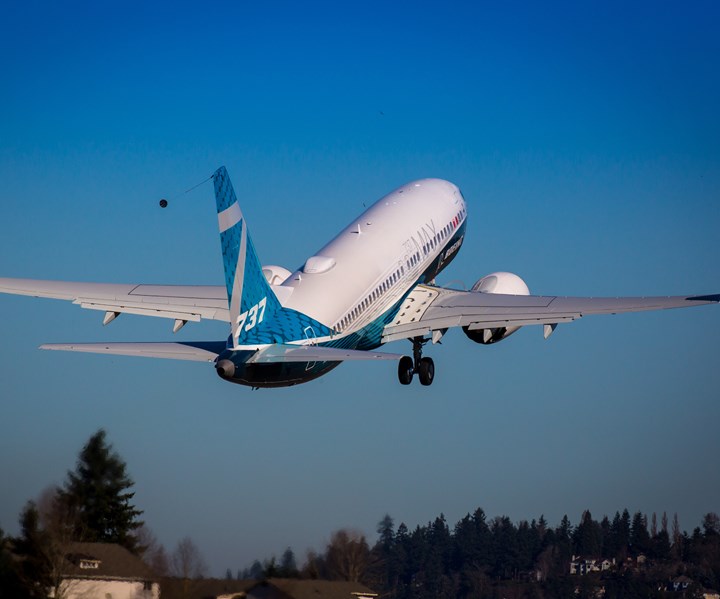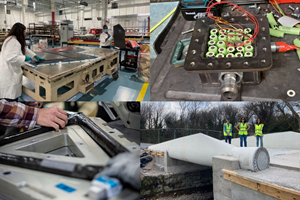The black swan events hitting the composites industry
From the Boeing 787 to COVID-19: When the out-of-the-ordinary becomes ordinary — and affects the manufacturing supply chain.

Boeing 737 MAX. Source | Boeing
It’s March 11 as I write this. One year and one day ago, on March 10, 2019, the world was hit by what turned out to be the first in a series of black swan events. Ethiopian Airlines flight 302 crashed shortly after take-off from Addis Ababa Bole International Airport in Addis Ababa, Ethiopia. Everyone onboard died.
The plane, of course, was a 737 MAX. As we all know, the crash precipitated the grounding of the entire global 737 MAX fleet of 387 aircraft, followed by the slowing and then stopping of 737 MAX production altogether in December 2019 (black swan #2). The aerospace supply chain, in the meantime, was thrown in disarray, with about 400 manufactured-but-not-delivered aircraft in storage by Boeing. Spirit AeroSystems (Wichita, Kan., U.S.), which makes the aluminum fuselage for the entire 737 product line, was forced to lay off 2,800 employees in January 2020. Hundreds of other Tier 2 and Tier 3 suppliers have been similarly impacted.
The harm done to the composites industry by the 737 MAX grounding has been, for the most part, indirect. Although there are some composites on the 737, they are mostly in the engines. The disruption we have felt is caused by 737 MAX ripples, as Boeing has committed vast resources to fixing the 737 MAX and getting it re-certified for flight. This has limited Boeing’s ability to focus on other projects.
Now is the time to prove the material capability, production capacity and technological aptitude required for next-generation aircraft.
Consider, for example, that prior to March 10, 2019, Boeing was on a path to announce sometime in 2019 the New Midsize Aircraft (NMA), a new twin-aisle, 200-270-seat, 4,000-5,000-nautical-miles range plane that would fit between the 737 MAX 10 and the 787-8 in the company’s lineup. The NMA, the thinking was, would provide a technological stepping stone for composite materials and process maturation, en route to development of a single-aisle replacement for the 737, Boeing’s most popular and most profitable aircraft. The NMA would have entered service around 2025, followed by a single-aisle replacement around 2030.
That plan, apparently, is on hold — at least until the 737 MAX is back in service. And the NMA may not come to fruition at all. Airbus, at the 2019 Paris Air Show, announced the A321XLR, a long-range version of the A321 that is designed to allow longer city-pair flights (i.e., Madrid-Dubai) in a single-aisle configuration. (Flying that far in a single-aisle aircraft may not sound appealing, but it definitely will be profitable.) Boeing, seeing the popularity of the A321XLR, is rethinking the NMA and might . . . what? Morph the NMA into an XLR derivation? Skip right to the single-aisle replacement? And if that occurs, what happens to the composites technology maturation we’d hoped for?
Airbus, for its part, is happy to watch Boeing struggle to bring the 737 MAX back to life and figure out next steps for the NMA/single-aisle replacement. It is assumed that Airbus will also develop a single-aisle replacement for the A320 (circa 2030 service date), depending in part on what path Boeing chooses. Airbus is pursuing, for a new single-aisle, several high-profile composites M&P development efforts, including an infused wing (Wing of Tomorrow) a thermoplastic fuselage (Clean Sky 2) and more.
… the world could see a 9% drop in passenger air travel as a result of COVID-19, which will put even more pressure on the economy in general and the aerospace supply chain in particular.
The aerospace composites supply chain is, of course, watching all of this anxiously. There is a great desire among raw material suppliers (carbon fiber, glass fiber, fabrics, resins, etc.), intermediates producers (weavers, braiders, prepreggers) and fabricators of finished parts and structures to be a part of the supply chain for next-generation aircraft. Now is the time to prove the material capability, production capacity and technological aptitude required for next-generation aircraft.
And then, of course, the black swan that is the 737 MAX was joined in January by the black swan that is COVID-19. Even as I write this, the virus has introduced such uncertainty into the global marketplace that air travel is depressed, schools have been closed, events (like JEC World 2020) have been postponed or canceled and the stock market has melted down (it’s down a whopping 5.9% today alone). Some air travel analysts suggest that the world could see a 9% drop in passenger air travel as a result of COVID-19, which will put even more pressure on the economy in general and the aerospace supply chain in particular. And no one knows how long it will be before normal returns.
But, normal will return. The 737 MAX will, gradually, return to
service. COVID-19 will fade, or at least become a part of the human
health landscape. New aircraft programs will be announced. And
even with future black swans the composites industry is still well-positioned for long-term growth.
Related Content
Welcome to the Composites Age
The human race has a long history of developing materials, each one a little better than the one before it. Composites are among the latest in a long line, and proving highly adaptable to new opportunities.
Read MoreAs 2023 begins, a look back at trending CW topics in 2022
With 2022 now behind us, CW’s editor-in-chief Jeff Sloan takes a look at the CW stories last year that received the most reader attention.
Read MoreUp, not out: The next chapter of CompositesWorld
I have been editor-in-chief of CompositesWorld for 17 years, which translates into a lot of editorials. This will be my last as I become publisher of CW. We welcome Scott Francis back to the brand to take my place.
Read MoreCompositesWorld is on the road again
Since CW’s infancy, its editors have strived to imbue its coverage with a sense of place, whether that’s through plant tours, facility visits or trade shows. After a pandemic, this has never seemed more important.
Read MoreRead Next
CW’s 2024 Top Shops survey offers new approach to benchmarking
Respondents that complete the survey by April 30, 2024, have the chance to be recognized as an honoree.
Read MoreComposites end markets: Energy (2024)
Composites are used widely in oil/gas, wind and other renewable energy applications. Despite market challenges, growth potential and innovation for composites continue.
Read MoreFrom the CW Archives: The tale of the thermoplastic cryotank
In 2006, guest columnist Bob Hartunian related the story of his efforts two decades prior, while at McDonnell Douglas, to develop a thermoplastic composite crytank for hydrogen storage. He learned a lot of lessons.
Read More

















.jpg;maxWidth=300;quality=90)








